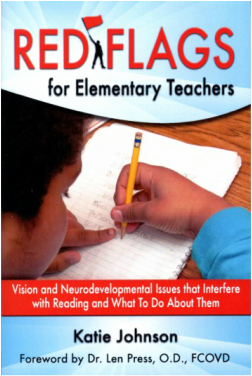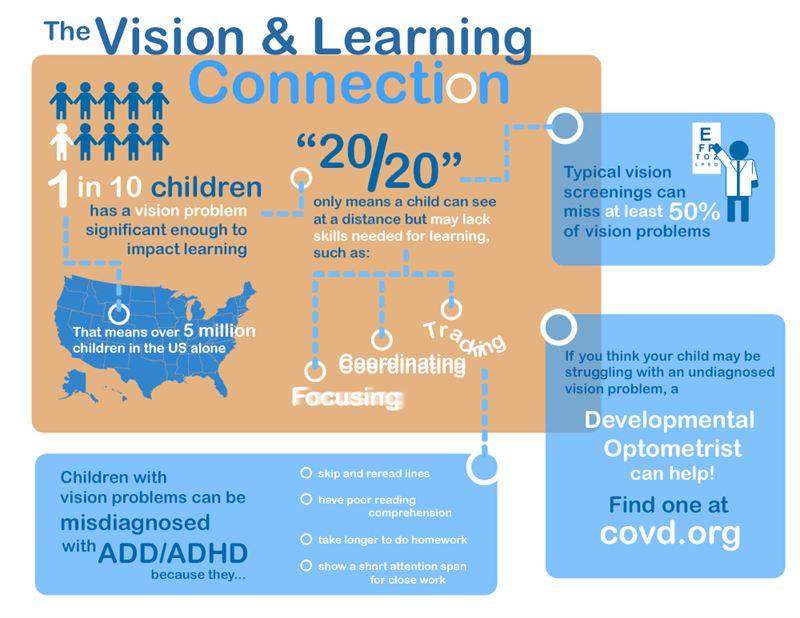Learning Disabilities Awareness Month: Inadequate Vision Screenings Contributing to Epidemic of Children with Learning Problems
Only two years after The Nation’s Report Card showed that only 38% of students could read at or above the level of “proficient,” our nation’s children continue to struggle with reading – at epidemic levels. Many parents are told their children aren’t far enough behind to warrant special services at school, yet they continue to struggle with reading and learning. Other children are misdiagnosed with learning disabilities when in fact they have undiagnosed vision problems at the root of their struggles.
“In June 2011, we featured a story about educators in New Jersey who routinely screen for learning-related vision problems. Their district had one of the lowest rates of student classification for special education services in their county,” states Dr. Kara Heying, President of the College of Optometrists in Vision Development (COVD). “In addition, parents shared that optometric vision therapy was one of the interventions that makes a big difference in their children’s ability to read and learn.”
It is a logical assumption that checking hearing and vision would be one of the first steps to identify why a child is struggling with reading. While eyesight, or visual acuity, is typically assessed, the main test is whether a child can see certain-sized letters from a distance of 20 feet (hence the term “20/20”). However, reading occurs at approximately 6 to 15 inches. People mistakenly assume that, if distance vision is fine, then vision at reading distance will be as well. This unfortunately means that vision isn’t tested at reading distance, nor are eye coordination and focusing taken into account.
Optometric research has shown that more than 10 million children struggle with reading and learning because of eye coordination and eye focusing disorders. Research also clearly indicates that both of these disorders are very treatable with optometric vision therapy. “While there is no critical period or age limit for vision therapy, early identification is always recommended,” states Dr. Heying.
“Most children who are having trouble with reading after working on it for four, or five, or six years are not easy to fix. They believe they are just stupid or just can’t do it. Why? Almost never are they stupid,” shares Katie Johnson, author of Red Flags for Elementary Teachers. Ms. Johnson has taught first grade, in both Maine and Washington, for 37 of the 46 years she has been a teacher. In addition, she has worked as an adjunct professor of literacy in the teacher-training programs of Pacific Oaks College (California) and University of Washington (Bothell campus), as well as in the graduate school of Lesley University (Cambridge, Massachusetts), and has done a multitude of professional development presentations all over the United States.


“These children have trouble with reading because something is not right with their vision: their eyes do not properly track across and/or down a page of print,” Ms. Johnson continues. “As they look at a page in a book, the print is fuzzy, or the words move, or (huge red flag) they can’t reliably tell the difference between similar letters and words. In addition, the older they get, the more practiced they become at masking their failings, making it hard for grown-ups to tease out what is habit and what is need.”
When she first learned about the visual connection to reading, Ms. Johnson started asking her struggling readers, “What do the words do when you are trying to read?” The answers she received astounded her: “I remember one girl who said, ‘I start on the side of the page and then the words start moving, when I get to middle where the staple is and the book is bending, the words fall in there and I can’t read.’ I would never have known this was happening if I didn’t ask her.”
“Children with eye coordination and eye focusing problems often report a variety of different symptoms depending on the depth and type of their vision problem,” Dr. Heying explains; “Many children often avoid reading before the words start moving around or doubling up, so they rarely report symptoms.”
To help parents and educators in identifying children who have eye coordination and eye movement disorders contributing to their academic challenges, COVD has released an infographic and a Public Service Announcement as part of observing Learning Disabilities Awareness Month. For more information visit: www.covd.org.
CONTACT: Pamela R. Happ, MSM, CAE
COVD Executive Director
330.995.0718 tel
Email: phapp@covd.org
Website: www.covd.org
About COVD
The College of Optometrists in Vision Development (COVD) is an international, non-profit optometric membership organization that provides education, evaluation, and board certification programs in behavioral and developmental vision care, vision therapy, and visual rehabilitation. The organization is comprised of doctors of optometry, vision therapists and other vision specialists. For more information on learning-related vision problems, vision therapy and COVD, please visit http://www.covd.org/ or call 330.995.0718.
A series of public service announcements (PSAs) are available at covd.org to help raise awareness that vision problems can not only interfere with learning, but sports performance, and other activities of daily living. These PSAs also address vision problems that impact individuals who have autism spectrum disorders or those who have suffered a head injury.
Tags:



